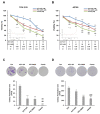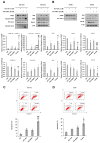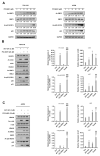HDAC8-Selective Inhibition by PCI-34051 Enhances the Anticancer Effects of ACY-241 in Ovarian Cancer Cells
- PMID: 35955780
- PMCID: PMC9369251
- DOI: 10.3390/ijms23158645
HDAC8-Selective Inhibition by PCI-34051 Enhances the Anticancer Effects of ACY-241 in Ovarian Cancer Cells
Abstract
HDAC6 is overexpressed in ovarian cancer and is known to be correlated with tumorigenesis. Accordingly, ACY-241, a selective HDAC6 inhibitor, is currently under clinical trial and has been tested in combination with various drugs. HDAC8, another member of the HDAC family, has recently gained attention as a novel target for cancer therapy. Here, we evaluated the synergistic anticancer effects of PCI-34051 and ACY-241 in ovarian cancer. Among various ovarian cancer cells, PCI-34051 effectively suppresses cell proliferation in wild-type p53 ovarian cancer cells compared with mutant p53 ovarian cancer cells. In ovarian cancer cells harboring wild-type p53, PCI-34051 in combination with ACY-241 synergistically represses cell proliferation, enhances apoptosis, and suppresses cell migration. The expression of pro-apoptotic proteins is synergistically upregulated, whereas the expressions of anti-apoptotic proteins and metastasis-associated proteins are significantly downregulated in combination treatment. Furthermore, the level of acetyl-p53 at K381 is synergistically upregulated upon combination treatment. Overall, co-inhibition of HDAC6 and HDAC8 through selective inhibitors synergistically suppresses cancer cell proliferation and metastasis in p53 wild-type ovarian cancer cells. These results suggest a novel approach to treating ovarian cancer patients and the therapeutic potential in developing HDAC6/8 dual inhibitors.
Keywords: ACY-241; HDAC6; HDAC8; PCI-34051; epigenetics; ovarian cancer.
Conflict of interest statement
The authors declare that they have no conflict of interest.
Figures





Similar articles
-
Overexpressed HDAC8 in cervical cancer cells shows functional redundancy of tubulin deacetylation with HDAC6.Cell Commun Signal. 2018 May 2;16(1):20. doi: 10.1186/s12964-018-0231-4. Cell Commun Signal. 2018. PMID: 29716651 Free PMC article.
-
The structural requirements of histone deacetylase inhibitors: C4-modified SAHA analogs display dual HDAC6/HDAC8 selectivity.Eur J Med Chem. 2018 Jan 1;143:1790-1806. doi: 10.1016/j.ejmech.2017.10.076. Epub 2017 Oct 31. Eur J Med Chem. 2018. PMID: 29150330 Free PMC article.
-
Histone deacetylase inhibitors suppress mutant p53 transcription via HDAC8/YY1 signals in triple negative breast cancer cells.Cell Signal. 2016 May;28(5):506-515. doi: 10.1016/j.cellsig.2016.02.006. Epub 2016 Feb 11. Cell Signal. 2016. PMID: 26876786
-
Are inhibitors of histone deacetylase 8 (HDAC8) effective in hematological cancers especially acute myeloid leukemia (AML) and acute lymphoblastic leukemia (ALL)?Eur J Med Chem. 2023 Oct 5;258:115594. doi: 10.1016/j.ejmech.2023.115594. Epub 2023 Jun 25. Eur J Med Chem. 2023. PMID: 37429084 Review.
-
Selective and nonselective HDAC8 inhibitors: a therapeutic patent review.Pharm Pat Anal. 2018 Nov;7(6):259-276. doi: 10.4155/ppa-2018-0019. Epub 2019 Jan 11. Pharm Pat Anal. 2018. PMID: 30632447 Review.
Cited by
-
Pathological Role of HDAC8: Cancer and Beyond.Cells. 2022 Oct 9;11(19):3161. doi: 10.3390/cells11193161. Cells. 2022. PMID: 36231123 Free PMC article. Review.
-
Inhibition of HDAC8 mitigates AKI by reducing DNA damage and promoting homologous recombination repair.J Cell Mol Med. 2024 Sep;28(18):e70114. doi: 10.1111/jcmm.70114. J Cell Mol Med. 2024. PMID: 39317961 Free PMC article.
-
Inhibition of HDAC8 Reduces the Proliferation of Adult Neural Stem Cells in the Subventricular Zone.Int J Mol Sci. 2024 Feb 22;25(5):2540. doi: 10.3390/ijms25052540. Int J Mol Sci. 2024. PMID: 38473789 Free PMC article.
-
The Roles of Histone Deacetylases in the Regulation of Ovarian Cancer Metastasis.Int J Mol Sci. 2023 Oct 11;24(20):15066. doi: 10.3390/ijms242015066. Int J Mol Sci. 2023. PMID: 37894746 Free PMC article. Review.
-
Synergistic HDAC4/8 Inhibition Sensitizes Osteosarcoma to Doxorubicin via pAKT/RUNX2 Pathway Modulation.Int J Mol Sci. 2025 Apr 10;26(8):3574. doi: 10.3390/ijms26083574. Int J Mol Sci. 2025. PMID: 40332124 Free PMC article.
References
-
- Weichert W., Röske A., Gekeler V., Beckers T., Stephan C., Jung K., Fritzsche F., Niesporek S., Denkert C., Dietel M. Histone deacetylases 1, 2 and 3 are highly expressed in prostate cancer and HDAC2 expression is associated with shorter PSA relapse time after radical prostatectomy. Br. J. Cancer. 2008;98:604–610. doi: 10.1038/sj.bjc.6604199. - DOI - PMC - PubMed
-
- Weichert W., Röske A., Niesporek S., Noske A., Buckendahl A.-C., Dietel M., Gekeler V., Boehm M., Beckers T., Denkert C. Class I histone deacetylase expression has independent prognostic impact in human colorectal cancer: Specific role of class I histone deacetylases in vitro and in vivo. Clin. Cancer Res. 2008;14:1669–1677. doi: 10.1158/1078-0432.CCR-07-0990. - DOI - PubMed
MeSH terms
Substances
Grants and funding
LinkOut - more resources
Full Text Sources
Medical
Research Materials
Miscellaneous

